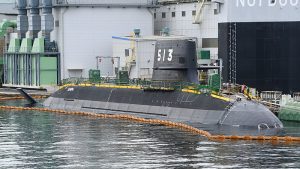A. B. Abrams

The announcement on September 15 that the United States and United Kingdom would support a Royal Australian Navy (RAN) program to acquire nuclear-powered attack submarines, the first of which will reportedly be launched by the end of 2039, represents one of the most significant developments of the year for East Asian security. Australia will become the seventh country to field such assets and the very first non-nuclear weapons state to do so, with U.S. reactors using weapons-grade uranium expected to power the new vessels.
The unprecedented deal has sparked concerns of a proliferation risk either through Australia’s eventual acquisition of nuclear arms or, more likely, through a sharing arrangement similar to what the U.S. currently has with several European allies. The latter possibility would see U.S. nuclear weapons, in this case cruise missiles, transferred to Australian service in the event of a major war, with the RAN training to use them until then, much as European states train to use U.S. nuclear gravity bombs today. All this remains speculation, however, and the possibility remains that Australia currently intends to field its attack submarines purely as conventionally armed assets for long-distance power projection.
Nuclear-powered attack submarines have the advantage over their diesel-electric counterparts of being able to cover longer distances at much higher speeds, and of having far higher endurances, which allow them to remain at sea longer without the need to refuel. This has made them particularly highly prized by Western powers, which are accustomed to fighting wars offensively and far from their shores. By some estimates nuclear-powered submarines will allow the Royal Australian Navy to maintain deployments in the South China Sea for seven times as long as diesel electric ones – 77 days at a time rather than 11.
The provision of nuclear-powered submarines to Australia has raised the question of whether other U.S. allies could be next, and of why the RAN was the first and only client for such weapons. This can partly be explained by the fact that the U.S. and Britain’s offering of nuclear-powered ships was likely key to allowing them to gain contracts that had previously been promised to France by improving on the French offer of 12 diesel-electric ships. Australia’s strategic location, however, makes its deployment of such ships a much greater asset to broader U.S. and Western interests than if other American allies did the same.
Japan and South Korea in particular, which have far larger defense budgets, would be much better able to afford such acquisitions but, for a number of reasons, are not expected to be offered similar technologies. Both East Asian states are much more industrialized and have long had sizeable submarine industries of their own producing diesel-electric powered ships. Japan’s submarines in particular, such as the new Taigei class, are thought to be much stealthier than any Western counterpart.
Beyond the significant discrepancy in military industries, Japan and South Korea’s locations make them far less well suited to deploying nuclear powered submarines, considering the security challenges that Washington is seeking to address by proliferating such weapons. Both Northeast Asian states are located near to the countries that challenge the perpetuation of Western-led order in the region, namely China, North Korea, and Russia. Diesel-electric submarines are thus considered more than sufficient, with the usefulness of nuclear-powered ships’ high endurances being ideal for power projection but far from necessary for short-range regional operations. Indeed, diesel-electric ships may be preferable when a high endurance is not needed as they are not only much more cost-effective both to build and to operate, but are also generally considered quieter and harder to detect.
This may change in the future for South Korea in particular, as it moves to build carrier strike groups capable of projecting power beyond Northeast Asia, for which high endurance submarines could provide a valuable escort as they do for U.S. carrier groups today. South Korea has also moved toward developing a possible second-stage strategic deterrent, as the only non-nuclear state to field submarine-launched ballistic missiles, and could seek nuclear-powered ships to accommodate these in the distant future.
Australia’s move to acquire nuclear powered submarines was far from inconsistent with trends in Canberra’s security discourse, with multiple reports in 2018-19 indicating that the country was considering acquiring nuclear weapons and reports subsequently indicating that B-21 bomber acquisitions were also being considered. The country’s most influential think tank, the Australian Strategic Policy Institute, was among those making the case for a B-21 acquisition. As an intercontinental-range bomber the B-21, like nuclear powered submarines, is the kind of asset that only nuclear weapons states have deployed in the past and is intended to hold targets an ocean away at risk.
While an Australian acquisition remains uncertain, a B-21 sale would reflect part of the same trend of Canberra seeking to acquire assets capable of projecting power into Northeast Asia and holding Chinese cities and bases under threat, which is highly beneficial for Washington as it contributes to upholding Western-led order in the region. Whether Australia acquires them or not, B-21s will complement its nuclear-powered submarines and are expected to be deployed on Australian soil by the U.S. Air Force with missions in East Asia firmly in mind.
As U.S. bases on Guam and Wake Island, let alone South Korea and Japan, are increasingly considered highly vulnerable to a new generation of Chinese and North Korean armaments, Australia’s importance will only grow. Its distance provides relative safety as Guam once did in the Cold War years, but it is still close enough to be a valuable staging ground for offensive operations. The provision of nuclear-powered submarines thus represents part of a wider trend toward Australia emerging as a central part of Western power projection efforts aimed at East Asia, with the country hosting new infrastructure and combat assets to this end.
No comments:
Post a Comment